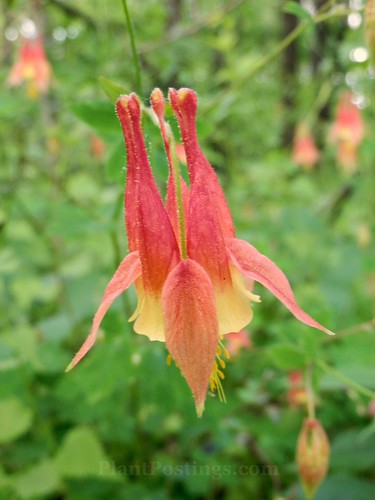
This plant, Aquilegia canadensis--common names, Wild Columbine or Eastern Red Columbine--is following me wherever I go this spring/summer. Do you ever get that feeling? That you're seeing the same plant everywhere?
I haven't left my own state this growing season, but I've been in the north, the south, and the middle sections of Wisconsin--in shade and sun and dappled-in-between. Places with sandy soil, clay soil, and loamy soil.

This native Columbine seems happy in just about every location--even growing out of rocks, as I mentioned in my last post. It's reblooming in a new pollinator garden I helped establish--out in south-facing, bright sun at the edge of a farm field.
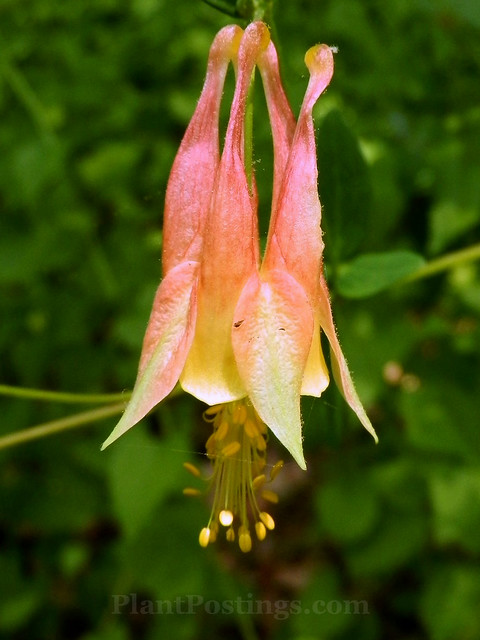
I've noticed Wild Columbine for most of my life, of course, but this year seems to be an especially good year for it and I seem to be particularly in love with it.
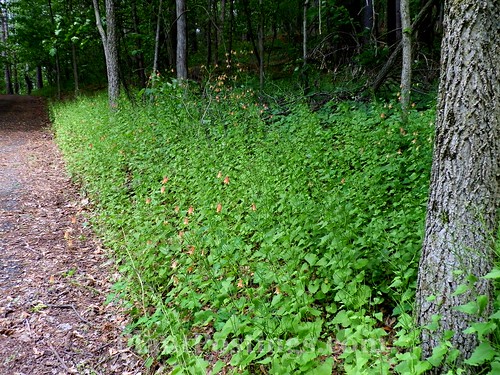
One especially nifty aspect of this plant, which I didn't realize until recently, is that it competes quite well with our non-native, invasive Garlic Mustard (Alliaria petiolata). During a hike in one of our state parks earlier this season, we noticed an overgrowth of Garlic Mustard.

The only other plant of significance in the forest understory was Wild Columbine. If you have a stubborn patch of Garlic Mustard, perhaps Columbine can help reclaim it.
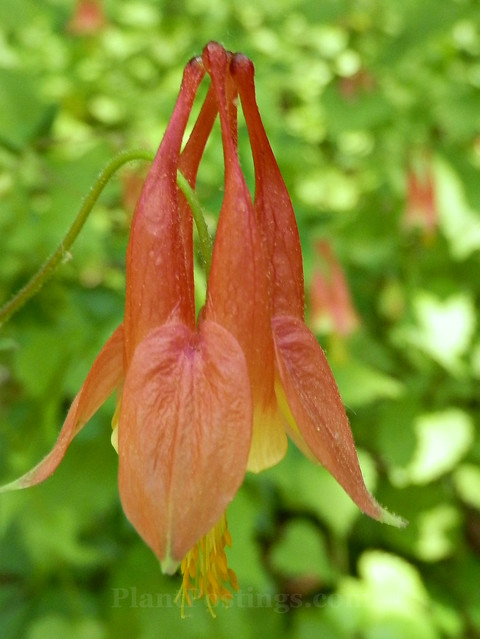
A. canadensis is native to most of North America east of the Rockies, according to the Lady Bird Johnson Wildflower Center. It's cold-tolerant, heat-tolerant, drought-tolerant, and moisture-tolerant. The blooms seem to be the perfect invitation to birds, butterflies, and hummingbirds--and I've seen them all enjoying its nectar, pollen, and seeds.
A larval host for the Columbine Duskywing butterfly, this plant readily reseeds, and most sources say it's best propagated by seed. It also readily hybridizes with other Columbines, which can yield some interesting color combinations. Some gardeners complain that it can be somewhat invasive.
When we first moved to our current property, we had a patch of Wild Columbine, but for some reason it disappeared. I recently added some back to the garden. I'm a big fan.
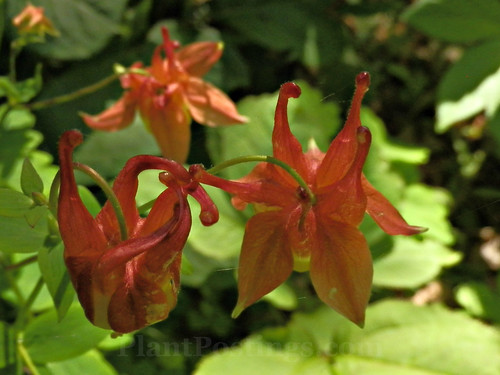
I'm also linking in with Gail's Wildflower Wednesday over at Clay and Limestone. (I made it just in time to call it a Wednesday post!)
So pretty . . . I really like the WILD Columbine, not a fan of the cultivated.
ReplyDeleteI actually like them all, but it's fun to see the wild, native one in so many places this summer. Such a beauty!
DeleteAs much as I like all the double & fancy varieties, it's hard to beat the original. I have one plant ~ it doesn't seem to seed around tho?
ReplyDeleteI don't have much experience with it in a garden setting. I remember seeing some growing along the forest edge when we first moved here, but maybe conditions weren't quite right for a while. I'm hoping my new plants will do well. And I do enjoy seeing it when I go hiking. :)
DeleteBeautiful photos. I have the wild and cultivated and love them both. The cultivated are so tall and like ballerinas among the iris and roses. The natives are in the shade bed near our stream. I'm so grateful for them all and yes, they do seem to be following us this year! What a lovely thought Beth.
ReplyDeleteThanks, Susie. :) Little moments of grace are so fascinating, aren't they? I never thought I'd see the Columbine out at the farm reblooming, but there it was--the perfect little bloom. I love all varieties of Columbines, too. Such a gentle, yet hardy little plant.
DeleteThat's a lovely plant Beth, a wonderful one to see everywhere, and a bonus if it can help limit invasives too.
ReplyDeleteYes, I was at first surprised to see how rampant the Garlic Mustard was in that setting, and then interested to see that the Columbine was so prevalent, too. We have a bit of a Garlic Mustard problem in our woods, although we pull it every year. Hopefully, the Wild Columbine will re-establish here, too.
DeleteThank you for the post on Wild Columbine. I'm very interested in it because it's a native. In all my years I haven't seen it growing wild here in SE MA. Nor have I seen it for sale locally. It is definitely on my list of must haves.
ReplyDeleteInteresting. I hope you can find some for your garden. Prairie Moon Nursery and Prairie Nursery, among others, sell it ... if you're interested in online ordering.
DeleteVery pretty! I love Wild Columbine and wintersowed some last year. Now I have little seedlings in one of my beds, though I don't know how long it will take them to start flowering. I've heard it's great to plant for hummingbirds, so hopefully they'll attract some to my garden!
ReplyDeleteNice! Yes, I've seen hummingbirds going to it at the pollinator garden--so fun to see! I wonder, too, how long it will take them to flower--maybe next spring/summer?
DeleteI love Columbine - though here only see it growing in gardens. This wild version seems to be beautifully coloured. Our garden varieties don't seem so rich - or maybe I've simply missed out on them.
ReplyDeleteI've been pleasantly surprised to see it growing in so many places, and now re-seeding at the farm. I hope my new plants bloom next year. It's a very photogenic plant, too. And I'm imagining shots from various angles to show its beauty.
DeleteMy columbines tend to flop, but they are not natives. I plan to introduce them to some neighbors that can prop them up. Staking just makes them look weird and ill-at-ease, like part crashers. Garlic mustard is listed as a noxious weed around here: how much nicer to replace it with columbines.
ReplyDeleteI like the way you describe them as "party crashers" when you have to stake them. I have some Daylilies like that. Yes, Garlic Mustard is a noxious weed here, too. It tastes great, but it blocks out all the native forest understory plants. I was pleasantly surprised to see that the Columbine can hold its own.
DeleteI've been seeing a lot of columbine this summer as well, even in places I've not previously seen it. Guess the weather is just right for it this year!
ReplyDeleteThat's what I was thinking, Heather. Our cooler summer must be encouraging it more than other years. What a pleasant surprise. :)
DeleteThis is one of my favorites for late spring and early summer. It seems a bit arbitrary about where it will grow, otherwise it is just a marvelous plant that makes me think of red and yellow chandeliers. Didn't know that it competes with garlic mustard.
ReplyDeleteI've always enjoyed it, too, but for some reason this year it's calling me. "You must re-plant me in your garden," it says. ;-)
DeleteThey are so beautiful up close! Unfortunately, i have not yet seen it in person.
ReplyDeleteI think so, too--beautiful close up, far away, and everywhere in between. And the hummingbirds love it, too!
DeleteBeautiful flowers! I have never seen here. Thanks for sharing
ReplyDeleteI hope you have a chance to see it someday, Endah. It really is a lovely plant!
DeleteI love this plant so much I added a bunch of it to my redesigned shade garden last fall. I love how tough and beautiful it is. There is a smaller cultivar but I prefer the tall one. :)
ReplyDeleteGood idea! I pulled out some Spirea shrubs that just weren't doing well at all along the front path along the foundation. Some of the Columbine will go there in place of the Spireas. I hope it will like the spots around the garden where I have planted it.
DeleteVery nice. It seems just as happy down here in Middle Tennessee as up in Wisconsin. Love adaptable and tough plants!
ReplyDeleteGood to know! And yes, yes, yes--adaptable plants are the best!
DeleteThank you, thank you! The garlic mustard has been awful this season, and I've been trying to find something that is as tough as it is. I have some columbine cultivars, but none of the natives--what a beautiful way to replace the weeds!
ReplyDeleteOh good! I hope it will help reclaim the area for you. I'm trying the same thing in some spots around near the woods--as well as closer to the house along the front path. I didn't realize Columbine was so adaptable to different soils and light conditions!
DeleteI really like this plant too. I am surprised it is still flowering. I saw it so early in Spring. I did not know it to rebloom. That really is a plus.
ReplyDeleteI was surprised to see it re-blooming, too. I'm wondering if part of the reason is our relatively cool summer weather. I saw it again on Thursday. Curious if it will still be blooming later this week when I go back to the pollinator garden.
DeleteI grew the western one, A. formosa, last year, and I thought I had lost it but finally saw it bloom, it is not as robust as the double Columbines I grew from seed. I hope it can form an clump and get bigger like yours, I really like the red color.
ReplyDeleteThe photos shown here are from hikes in various locations around the state. The Columbines I recently added to my garden are foliage only, and I doubt they'll bloom this year again. But I'll look forward to (hopefully) seeing the blooms next spring/summer! Like you, I do hope mine will form nice, healthy clumps!
DeleteBelieve it or not, a lot of gardeners have trouble growing this plant. I have good luck with it on a part sun slope and, as you point out, in a very sunny spot where it planted itself. I love it.
ReplyDeleteWow, I'm surprised. Because they seem to grow everywhere around here--at least this summer. I hope my new ones will do well and bloom next spring/summer. I planted some in various spots, and seeded in several areas, as well.
DeleteI grow another columbine that I love, and I have hesitated introducing the native form, because I want the seedlings to come true. However, I once came upon a stand of the wild ones in the woods, and I have been tempted to plant some in another area in my woodland garden. They are so charming!
ReplyDeleteI can understand that, Deb. I recently added another Columbine cultivar, as well. I'll try to separate them, but we'll see what happens. Anything this beautiful and adaptable is a "yes" for me!
DeleteI'm a big fan also!
ReplyDeleteHi Greggo: Love the adaptable plants that help the pollinators, too! :)
DeleteHi Beth, now that is an adaptable plant! I guess many gardeners would wish that other plants in their gardens would be that tough. I only knew the hybridized form of columbine so far and it was interesting for me to read about the wildflower. The photo with the water behind the Wild Columbine is particularly pretty! I wonder if the wild form grows in Southern California as well. Warm regards,
ReplyDeleteChristina
Thanks, Christina. Yes, I didn't realize just how adaptable it is until recently. I would think it would grow for you in your mild climate, even though it's not native there. It looks like A. formosa (a similar species) is native for you: Western Columbine.
DeleteWhat a beautiful Columbine! They are one of my favourite plants and so well here in my UK garden.
ReplyDeleteThey are beautiful, aren't they? I think the UK must be one of the best places in the world to have a garden! I'm not surprised that Columbines like your climate!
DeleteI think my best spot to get this to establish is in the meadow since it is changed as soon as the non-native columbine bloom....the meadow is far enough away that I think they may be safe there.
ReplyDeleteYour meadow seems like the perfect place, Donna! Now I'm picturing Columbines waving in the wind there along with all your other beautiful plants.
Delete